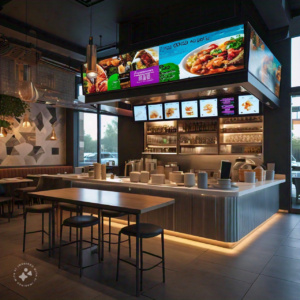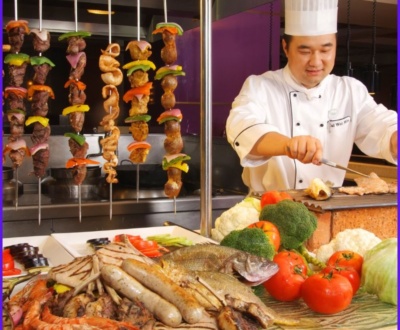Benefits of Digital Menu Board(step by step guide for restaurant)
- October 12, 2024
- Uncategorized

“Boost Your Restaurant’s Appeal with Digital Menu Boards: Engage Customers, Save Costs, and Update Menus Instantly!”
Benefits of Digital Menu Board
In recent years, the restaurant industry has experienced a significant transformation, driven largely by advancements in technology. One of the most prominent trends shaping this evolution is the adoption of digital menu board solutions. But what exactly is digital dining, and why are restaurants increasingly embracing it? In this blog post, we’ll explore the Benefits of Digital Menu Board.
Understanding Benefits of Digital Menu Board-
Digital menu Board encompasses a range of technologies designed to enhance the dining experience through automation and connectivity. This can include everything from online reservations and digital menus board to contactless payments and table-side ordering via tablets. As consumers become more tech-savvy, their expectations for dining experiences have evolved, making digital solutions not just beneficial but essential for restaurants looking to thrive in a competitive market.
Main Reasons Restaurants are Turning to Digital board
1. Enhanced Customer Experience
One of the primary reasons restaurants are adopting digital board solutions is to enhance the customer experience. In an age where convenience is king, diners appreciate the ability to view menus, place orders, and pay for their meals with minimal hassle. Digital menus allow for real-time updates, enabling restaurants to highlight specials, provide detailed descriptions, and even show allergen information. This level of transparency not only helps customers make informed choices but also reduces wait times, creating a more enjoyable dining experience.
2. Increased Operational Efficiency
Digital menu board solutions streamline many aspects of restaurant operations, leading to increased efficiency. By automating order-taking and payment processes, staff can focus more on providing excellent service rather than getting bogged down in administrative tasks. For example, with tablets for table-side ordering, servers can send orders directly to the kitchen, reducing the risk of errors and speeding up service This efficiency not only improves the customer experience but also allows restaurants to serve more guests in a given time frame, ultimately boosting revenue.
Process Optimization
- Streamlining Workflows: Analyze current workflows to identify bottlenecks and inefficiencies. Implement lean management principles to eliminate waste.
- Automation: Use automation tools for repetitive tasks (e.g., data entry, reporting) to free up employee time for more strategic activities.
. Technology Integration
- Utilizing Software Solutions: Implement project management, CRM, ERP, and other software solutions that enhance collaboration and data management.
- Data Analytics: Leverage data analytics to gain insights into performance metrics and make informed decisions based on real-time data.
3. Data-Driven Insights
Implementing digital board solutions provides restaurants with valuable data that can inform decision-making. Through point-of-sale (POS) systems and customer relationship management (CRM) software, restaurants can track customer preferences, popular menu items, and peak dining times. This data allows restaurateurs to tailor their offerings, optimize inventory, and create targeted marketing strategies, leading to improved customer satisfaction and increased sales.
Understanding Data Types
- Quantitative Data: Numerical data that can be measured and analyzed statistically (e.g., sales figures, website traffic).
- Qualitative Data: Descriptive data that provides context and insights (e.g., customer feedback, survey responses).
- Structured Data: Organized data in fixed formats (e.g., databases, spreadsheets).
- Unstructured Data: Data that does not have a pre-defined structure (e.g., social media posts, emails).
. Data Collection
- Sources of Data: Gather data from various sources such as CRM systems, ERP systems, social media, web analytics, and customer feedback.
- Data Quality: Ensure that data is accurate, complete, and relevant. Implement data cleaning processes to remove duplicates and correct errors.
4. Adaptation to Market Trends
The COVID-19 pandemic accelerated the shift toward digital board, as safety and hygiene became top priorities for diners. Restaurants quickly adopted contactless ordering and payment methods to reassure customers and comply with health guidelines. As a result, many diners have grown accustomed to these digital solutions and now expect them as part of their dining experience. Restaurants that embrace digital menu are better positioned to meet these evolving expectations and adapt to market trends.
. Market Research and Analysis
- Trend Identification: Regularly conduct market research to identify emerging trends, consumer preferences, and technological advancements. Utilize tools such as surveys, focus groups, and social media analytics.
- Competitor Analysis: Analyze competitors to understand their strategies, strengths, and weaknesses. This can provide insights into market positioning and potential opportunities for differentiation.
. Agility and Flexibility
- Agile Methodologies: Implement agile frameworks that allow for quick adaptation to changes in market demands. This can involve iterative processes and short development cycles.
- Cross-Functional Teams: Create cross-functional teams that can quickly pivot and respond to market changes, ensuring that diverse perspectives are considered.
. Customer-Centric Approach
- Feedback Loops: Establish channels for gathering customer feedback to understand their evolving needs and preferences. Use tools like surveys, social media listening, and customer reviews.
- Personalization: Utilize data analytics to offer personalized experiences and solutions that cater to individual customer preferences, enhancing satisfaction and loyalty.
. Innovation and Product Development
- Continuous Innovation: Foster a culture of innovation where employees are encouraged to develop new ideas and solutions. This could involve hackathons or innovation labs.
- Rapid Prototyping: Use rapid prototyping techniques to develop and test new products or services quickly, allowing for adjustments based on market feedback.
. Monitoring Industry Trends
- Stay Informed: Subscribe to industry publications, attend conferences, and join professional networks to stay updated on trends and best practices.
- Trend Analysis Tools: Utilize tools and platforms (e.g., Google Trends, TrendWatching) that track industry trends and consumer behavior to gain insights.
. Strategic Partnerships
- Collaborations and Alliances: Form strategic partnerships with other organizations to share resources, expertise, and technology. This can enhance capabilities and speed up adaptation.
- Ecosystem Engagement: Engage with startups, research institutions, and industry associations to explore new ideas and technologies.
. Scenario Planning
- Develop Scenarios: Use scenario planning to envision various future market conditions and prepare strategies for different outcomes. This helps organizations remain resilient amid uncertainties.
- Risk Management: Identify potential risks associated with market changes and develop contingency plans to mitigate them.
. Utilizing Technology
- Data Analytics: Leverage data analytics and business intelligence tools to analyze market trends and customer behavior, enabling data-driven decision-making.
- Digital Transformation: Invest in digital technologies to improve operational efficiency and enhance customer engagement, allowing for quicker responses to market changes.
5. Competitive Advantage
In a crowded restaurant landscape, having a digital board, solution can set a restaurant apart from its competitors. Offering a seamless, tech-driven experience can attract tech-savvy consumers looking for convenience and efficiency. Moreover, positive online reviews and word-of-mouth recommendations can further enhance a restaurant’s reputation, leading to increased foot traffic and loyalty among customers and restaurants are many Benefits of Digital Menu Board
. Understanding Competitive Advantage Types
- Cost Leadership: Achieving the lowest operational costs in the industry, allowing for lower prices or higher margins. This often involves economies of scale and efficient production processes.
- Differentiation: Offering unique products or services that provide value beyond the price, allowing for premium pricing. Differentiation can stem from quality, features, branding, or customer service.
- Focus Strategy: Targeting a specific market niche, allowing for tailored offerings that meet the unique needs of that segment, whether through cost focus or differentiation focus.
. Building Strong Brand Equity
- Brand Recognition: Develop a strong brand identity that resonates with customers. A well-recognized brand can command loyalty and justify premium pricing.
- Customer Experience: Create a positive customer experience at all touchpoints to enhance brand perception and encourage repeat business.
. Innovation and R&D
- Continuous Improvement: Invest in research and development (R&D) to innovate and improve products and services. This keeps the company ahead of competitors and can lead to unique offerings.
- Adopting New Technologies: Stay at the forefront of technology advancements to enhance products, streamline operations, or improve customer interactions.
. Customer-Centric Strategies
- Understanding Customer Needs: Conduct market research to understand customer preferences and pain points. Tailor products and services to meet these needs effectively.
- Loyalty Programs: Implement customer loyalty programs that reward repeat business, enhancing customer retention and creating a loyal customer base.
. Operational Efficiency
- Streamlining Processes: Identify and eliminate inefficiencies in operations to reduce costs and improve service delivery. Lean management practices can be beneficial.
- Supply Chain Optimization: Optimize the supply chain to reduce costs, improve quality, and enhance responsiveness to market changes.
. Strategic Partnerships and Alliances
- Collaborations: Form strategic partnerships with other companies to leverage their strengths, share resources, and enter new markets. This can enhance capabilities and competitiveness.
- Joint Ventures: Explore joint ventures for co-developing products or entering new markets, sharing risks and rewards.
. Effective Marketing Strategies
- Targeted Marketing: Utilize data-driven marketing strategies to effectively reach and engage target audiences. Personalization can enhance marketing effectiveness.
- Digital Presence: Invest in digital marketing to expand reach and engagement through social media, content marketing, SEO, and online advertising.
. Talent Management and Culture
- Employee Training and Development: Invest in employee training to enhance skills and capabilities, fostering a knowledgeable and competent workforce.
- Positive Organizational Culture: Cultivate a positive workplace culture that encourages innovation, collaboration, and employee satisfaction, leading to higher productivity and retention.
. Adaptation to Market Changes
- Agility and Flexibility: Develop an organizational structure that can quickly adapt to changing market conditions and customer demands.
- Monitoring Trends: Regularly analyze industry trends, consumer behavior, and competitive actions to remain proactive rather than reactive.
. Sustainability and Corporate Social Responsibility (CSR)
- Eco-Friendly Practices: Implement sustainable business practices that appeal to environmentally conscious consumers and can create long-term operational efficiencies.
- Social Responsibility: Engage in CSR initiatives that align with brand values, enhancing reputation and customer loyalty.
6. Sustainability
Digital board can also contribute to sustainability efforts within the restaurant industry. By reducing the need for paper menus, receipts, and promotional materials, restaurants can lower their environmental footprint. Additionally, digital systems can help optimize inventory management, reducing food waste and improving overall efficiency.
Conclusion
In this Blog we explore Benefits of Digital Menu Board. The shift toward digital Menu Board is more than just a trend; it represents a fundamental change in how restaurants operate and interact with their customers. By enhancing the dining experience, increasing operational efficiency, driven insights, and adapting to market trends, restaurants can position themselves for success in a rapidly changing landscape. As technology continues to evolve, embracing digital menu board will be essential for restaurants looking to thrive in today’s competitive environment.
More from our blog
See all postsRecent Posts
- Understanding What is SEO in Digital Marketing : A Comprehensive Guide December 30, 2024
- Benefits of Digital Menu Board(step by step guide for restaurant) October 12, 2024
- Why SEO is important for Restaurant? October 12, 2024








Pingback: Restaurant marketing strategy with 7 Ps (A - Dghackers